From February 21st to the 23rd, over 50 aikido practitioners gathered at Hiroshi Ikeda’s Boulder Aikikai to teach and learn from each other at a seminar designed specifically for the younger practitioners of aikido. Evolene Premillieu, founder of Aikido for Tomorrow, produced the event as a way for practitioners under the age of forty to train together and forge new connections and friendships with others from their generation. With support from older members of the aikido community, Evolene recruited 11 instructors who represented diverse perspectives on teaching and training methods.
Aikido Journal is pleased to share impressions and insights from instructors and participants at this groundbreaking event. We applaud this group of young leaders for their vision, enthusiasm and efforts and believe the entire aikido community should reflect carefully on their words. This group is critical to the future of our art. They represent an important part of society that is largely absent from our dojos- who we need to breathe more life into our dojos, and to serve as the next-generation of sensei and leaders in the art of aikido.

Evolene Premillieu, Seminar Organizer, Age 30
“A little over a year ago, I started talking to Hiroshi Ikeda Sensei about doing a Bridge seminar for young people. He told me to do something, but “not just another Bridge seminar” and to talk to him when I had a better idea… For months, he pushed me to develop something innovative, which ultimately led to this event. My priority was to bring young people together to form a community within the larger aikido community – one that connects young practitioners in a way that spans dojos, styles, and organizational affiliations, centered on our mutual love for aikido.
I received wonderful support from Ikeda Sensei (7th dan) and Tres Hofmeister Sensei (7th dan), who helped me organize the event and attended the entire seminar as a participant. Not everyone received the idea in such a positive way initially, but the encouragement and backing of my teachers and other senior instructors in the aikido community was really encouraging and helped to make the event a success.
We selected a group of teachers for the event who are all under the age of 40 who represent different affiliations and lineages. We structured the seminar with outdoor training and even had a class with music. Many participants stayed together in the dojo and we shared meals and mat space to sleep. This made the weekend more affordable for people but also created a unique bond and closeness between all of us.

We had over 50 people from 27 different dojos attend with 46 under the age of 40. The youngest was 19 and the oldest was 78. I was overjoyed with the event and was so happy to be able to create a venue for younger practitioners to connect with the support of some of our most senior level instructors.”
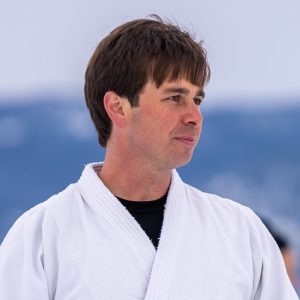
Nico Secunda, Seminar Instructor, Age 31
“I started aikido at 6 years old and have continued my training at Aikido of Santa Cruz since that time. Now, after quite a few years, and just recently turning 31, I still remain among the younger members of most classes and seminars I attend. My teachers, Linda Holiday Sensei and Motomichi Anno Sensei have both reiterated their desire for the younger generations to carry on the heart of aikido into the future and they have encouraged me to do all I can to support and inspire my peers in sustaining their practice. When Evolene first discussed the idea for Aikido for Tomorrow with me, it was so clearly in alignment with the vision both my teachers and I hold, that I instantly offered my wholehearted support.
When I look around at most dojos and seminars that I have attended, there is an overwhelming sense that the younger generations of adults are missing among the sea of grey hair. It seems it is the time for those few younger people who have the experience and support of their teachers, to step up and become beacons among their generation so that new energy may continue to flow into dojos and onto the mat. In this way, hopefully the future of aikido will be illuminated for all of us.
I was continually impressed not only with the amazing quality of the teaching from each instructor but also from each person I trained with throughout the seminar. I felt as if each class, each partner, each technique offered an opportunity for me to rise to another level and bring my best self forward. My hope is that Aikido for Tomorrow offers a community for the younger generations of aikidoka around the globe to connect with and inspire one another in order to sustain the way of aikido into the future.”
“No one was suggesting an aikido future without seniors or anything of the kind; on the contrary, everyone seemed to have a real fondness for their teachers and gratitude for our shared practice, made possible through the efforts of those who went before us.” – Tres Hofmeister
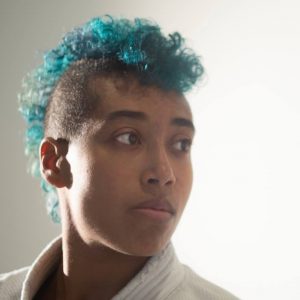
Sam Taitel, Seminar Instructor, Age 25
“I have yet to meet another young, queer, black woman in aikido. Finding even one match in my demographic is exciting and fairly rare. That is extremely sad. Underrepresented is not strong enough of a word. People like me aren’t on the mat practicing aikido. Why is that? This seminar is one of the first times that question was acknowledged and addressed openly in a group. The biases and injustices that exist and need to be addressed in the world are in aikido too. Beyond acknowledgement, action needs to be taken. Authentic and deep work must constantly be done to ensure we are always learning and moving towards being an inclusive and welcoming community. Recently some folks have truly been stepping up in their efforts to support a new generation of aikido practitioners and teachers. I am thankful to be a part of that wave.
Aside from teaching, it was wonderful not only getting to take classes, but to train with the instructors while they were also trying to figure out what was being taught. It felt more inclusive because the teacher was an accessible training partner. The teacher wasn’t put on a pedestal. It was clear that every individual wanted to be in class learning and importantly that their aikido journey was still in process.”
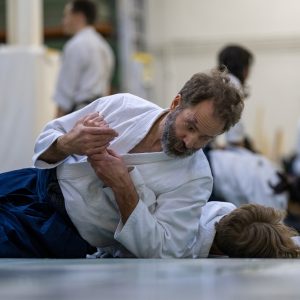
Tres Hofmeister, Participant “I’ve trained at Boulder Aikikai under Hiroshi Ikeda Sensei for most of my aikido life, where I continue to teach and practice. My most recent aikido grading is nanadan (7th dan), through the Aikido Schools of Ueshiba, of which I’m a senior member. I heard about the event directly from my friend and fellow Boulder Aikikai member, Évolène Premillieu, who took the initiative to organize this event. Supporting younger practitioners and teachers seems important for the future of aikido. I expect to be practicing for a while yet myself and would like to be part of a vital, thriving population that has a future. As a member of the hosting dojo, it was also important to me to welcome everyone willing to come, and to offer support through joining the practice. I really enjoyed the seminar! I met many people and enjoyed the practice and overall feeling of the seminar, which reminded me of how seminars used to feel, frankly—energetic, hopeful, with a lot of mutual interest between and among people attending. Everyone responsible for instruction was also out in the group during other classes, practicing. No one was suggesting an aikido future without seniors or anything of the kind; on the contrary, everyone seemed to have a real fondness for their teachers and gratitude for our shared practice, made possible through the efforts of those who went before us.”
“I have been very fortunate in terms of being supported by various high level instructors. My teacher, Jan Nevelius Sensei, is constantly coaching me and pushing me to higher levels not just in my own training but also in teaching. Kayla Feder Sensei has been incredibly welcoming and open minded in allowing me to train at her dojo. Matt Fluty Sensei has given me numerous opportunities to teach at his dojo in Sacramento. The generations before us began their teaching careers as young people, and as such they were able to draw young people into Aikido. As they get older it is imperative that they support young teachers to maintain the art.” – César San Miguel
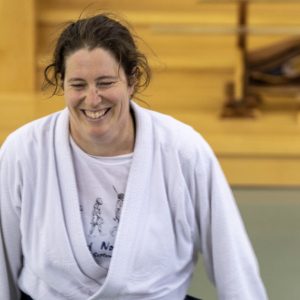
Gaia Marrs, Seminar Instructor, Age 38
“I was so happy and appreciative that some senior teachers and folks from the local area came and trained all weekend. They all said that it was a marvelous weekend and how much they enjoyed the teaching and training of the Aikido for Tomorrow group. I think that speaks to the need for young people to start taking leadership positions in the Aikido world, and that we have something valuable to offer to the community (while still having immense respect and appreciation for our senseis and not wanting them to go away of course!).
Along those lines, I think we have an issue with the transition from the senior teachers (some of whom still trained with O’Sensei, or at least who came from Japan in the relatively early days) to the younger generation. When they came to the US and started opening dojos, they were younger than many of us in the Aikido for Tomorrow crowd are now, with no more years or ranks under their belt (many of the folks at this seminar started as kids and have been training for decades already). If we ever hope to be close to as skilled at technique and teaching as our senior senseis/sempai are, we need to start taking leadership roles, running dojos, leading seminars, running tests, etc., but those positions are all filled by our senior teachers, whom we have a huge love and respect for and certainly want to keep learning from. I don’t know exactly what the answers are, but it would be good to see more of these senior teachers start to purposefully create opportunities for younger people to take on leadership roles (not only passing them to their senior student who is only a few years younger than they are) and offering mentorship and advice while also allowing them to make the art their own. Some are certainly doing this but I think it needs to be done more if the art is going to survive and thrive.”
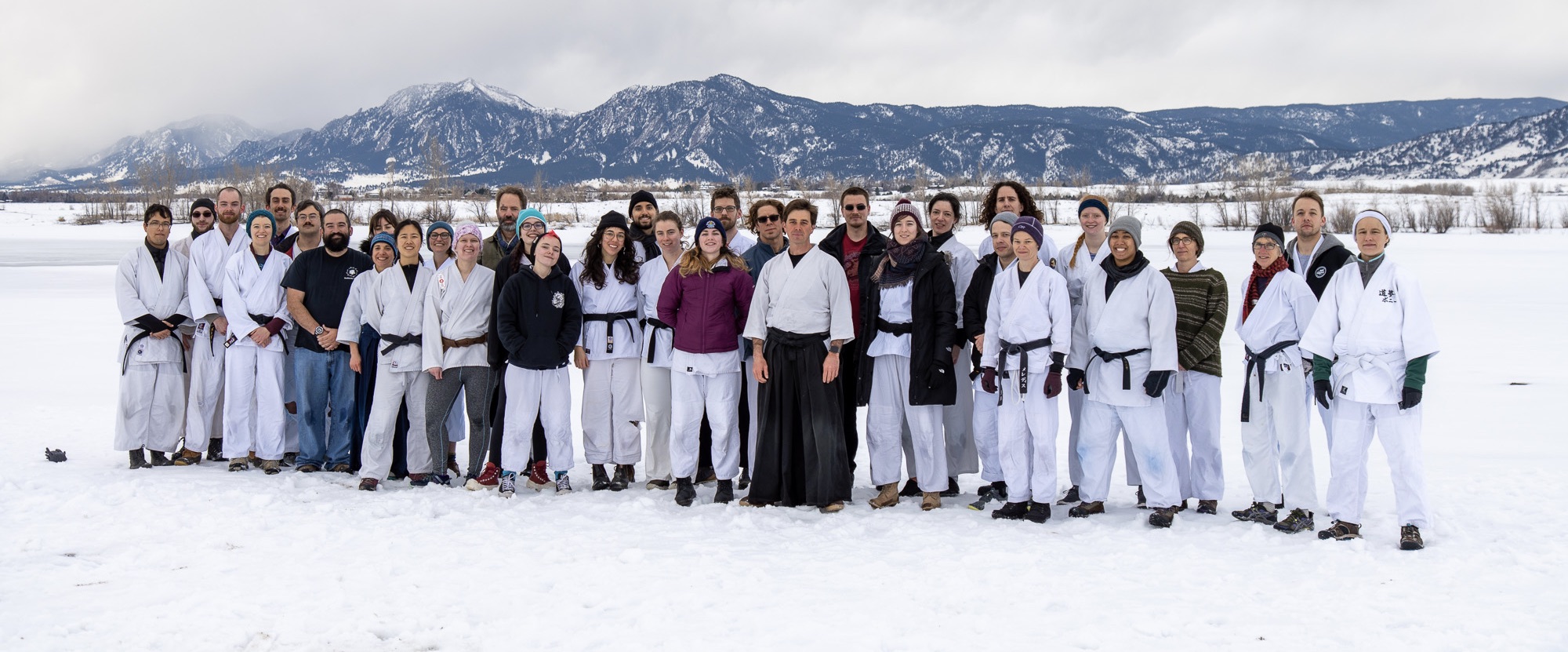
“Training outside for some of the sessions was amazing. I’ve often read about martial arts training in the snow, but have never experienced it until now. It was invigorating and it made break falls quite a bit easier.” -Matthew Dalldorf
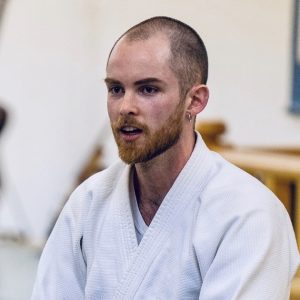
Gordon Allen, Seminar Instructor, Age 27
“My senseis Kayla Feder and Michael Friedl have both been very supportive of my starting to teach. Both of them have given me opportunities to teach classes at their dojos. My senseis are all over the age of fifty, and some of my most energetic and skilled training partners are over fifty, and I don’t believe that age is an impediment to sincere intense training. However, I also do not see the aikido community making a concerted effort to reach out to young people and people of color and underserved communities. Without a diverse coalition of aikidoka this art will not be able to thrive. I do feel that training in many dojos is geared toward older people, and often practiced without awareness of the lived experiences of marginalized folks who might find it hard to stay on the mat.”

Christine Cornell, Participant, Age 20
“I am lucky to have come from a dojo with a really good teen program with a lot of enthusiastic teenagers. The sad part is that many teens when they leave for college end up not returning to aikido which makes for a gap between the older teens and the youngest adults. At the dojo I currently train at, the dynamic is very different, I think the age gap between me and the next youngest is probably at least 7 to 10 years. There are very few younger aikidoists and the speed of training is often pretty slow. This is not to say that it is in any way a bad dojo. On the contrary, every day I train I learn more about aikido, I just don’t always get up a sweat while doing so.
I think in general what I miss is high-stakes fast training. At some seminars there just isn’t room on the mat for this and that’s obviously a different conversation. I do really appreciate all kinds of training but to improve my ukemi I really appreciate faster training. It is not always possible to create opportunities like this, but at seminars it would be cool if it were easier to find.
I really appreciated that throughout the seminar I was always falling down, always training hard, and always learning. I also greatly appreciated that the ego was non-existent in the instructors- all of the instructors trained in all the other classes and trained with anyone and everyone.
The most impactful and memorable moment for me was sitting around with peers and friends and talking about aikido. Specifically talking about aikido from a younger perspective with other people who share that perspective. It was so meaningful to me that at times I would express something that I thought was just my experience and hear someone elaborate on that in a way that showed how much they understood and had a similar experience. “
“This was the first seminar I attended where the majority of participants slept in the same place (at the dojo). I felt this seminar was amazing in that it helped us, as the newer generation of aikidoka, to begin to build a network with our peers in an environment we may not otherwise have been privy to. The way we spoke to and listened to each other also felt more on a level setting where rank was ignored and experience was respected.” – Bonnie White
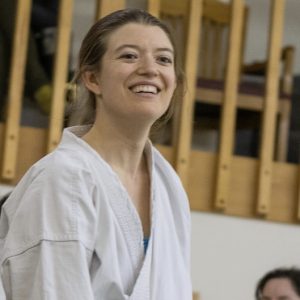
Naomi Barshi, Participant, Age 30
“I get so much from my regular training and seminars. My dojos and the seminars I attend are rich and vibrant and full of the wisdom of our teachers, peers, and newer students. I deeply value the training of those who have come before me and the teachings they have to offer. I soak up all I can so that I can hold their teachings and pass them on when our teachers are no longer with us.
Coming to this event, I was really inspired to see what we could gain from taking the opportunity to train with our age-peers. We have shared experiences of our generation, both in society and in aikido. We can come together to hone our vision for how to sustain what we learn from our sempai and strengthen our training each day as we step into the future of aikido. To keep aikido alive, we must nurture it and train with those who came before us while also supporting those who will follow us.
My generation seeks meaningful, personal, physical connection. So much of our lives take place online, where an aspect of interpersonal communication is inherently missing. Aikido fills that gap for me. In training, I immediately know a person deeper than their name or age or salary or occupation. Our society also increasingly splits across political divides. Aikido can help us find deep connections with people that are not political, not charged with personal value or any need to get ahead. I think that if we suggest Aikido as a way to bridge our gaps and fill our need for meaningful personal connections, perhaps we could attract and retain more people.
I think a pertinent question is about making aikido more inclusive for everyone, regardless of social identity. Aikido itself does not discriminate based on age, gender, sexuality, religion, ethnicity, or even physical ability. We must follow what aikido teaches us about equality and justice to connect unconditionally with every person and seek peaceful solutions that unite us rather than divide us. We have major social and economic barriers to overcome that are part of broader issues of institutionalized oppression. Aikido practice in a dojo costs money and requires transportation to and from the dojo. It takes time and keeps us from our families around dinner or on weekend mornings. Practicing a martial art is not always seen as a viable activity. We tend to keep doing things in which we can see ourselves in those who have succeeded. While the currency of aikido is unconditional Love, the logistics of aikido often bar those who have limited money, time, and exposure. We need to foster a culture of practice that follows the principles of aikido in its core and actively welcomes everyone. Onegaishumasu! “

Special thanks to Evolene and all the instructors and participants who supported this special event and provided feedback to Aikido Journal. While we could not include comments from all the participants at this event, we’d like to thank the following attendees for providing their insights and perspective: Alex Gholz, Alix Tiran-Capello, Anastasia Shuba, Bénédicte Bonnet, Bonnie White, César San Miguel, Christine Cornell, Connor Albach, Evie Lynch, Evolene Premillieu, Gaia Marrs, Gordon Allen, Kay Rudisill, Matthew Dalldorf, Naomi Barshi, Nico Secunda, Ola Karasik, Paul Nicholson, Reina Krumvieda, Sam Taitel, and Tres Hofmeister.




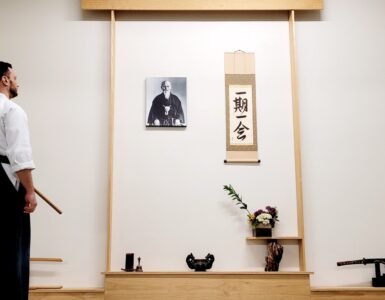








Involving younger people in the teaching process is a must for the survival of this art. This seems a prudent way to begin to achieve this. Additionally, I would encourage the exploration of ‘DIVINE TECHNIQUE’ (Takemusa Aiki) as it is the highest level of the art. Since developing this skill set takes many years, it would be wise to start this process with younger persons.